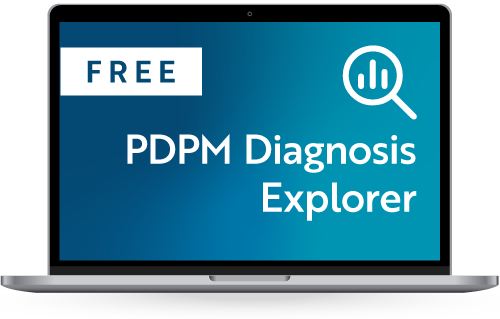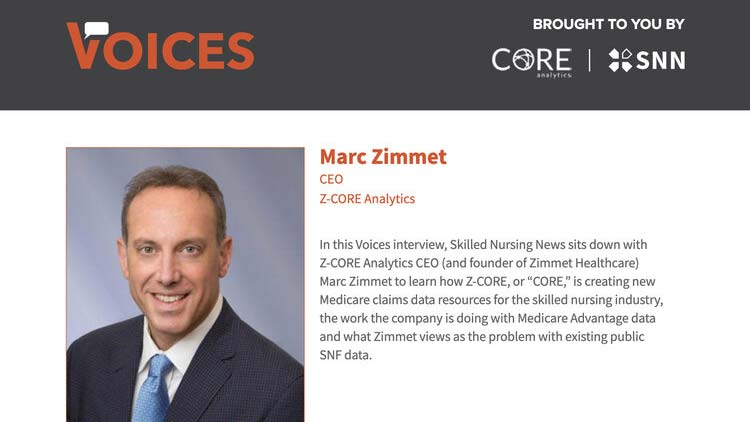You are the CEO of Z-CORE Analytics, and you’ve had a long career beyond this. What are the origins of your work with Z-CORE?
I’ve been in the skilled nursing space for almost 30 years, all with a concentration on reimbursement-compliance. When I started my career, Medicare payment was driven by annual cost reports and apportioned based on ancillary charges from the UB-92, since updated to the UB-04. When the Part A payment system transitioned to PPS in the late 1990s, everything changed. Suddenly the Minimum Data Set (MDS), managed by nursing, was the driver of reimbursement, then mispriced reimbursement for rehab shifted control to the therapy department.
The critical distinction here is that the MDS is not a payment tool – it’s a clinical assessment retrofitted for rate setting. The UB was and continues to define the SNF revenue cycle.
As the MDS became the center of the SNF rate equation, the UB was largely ignored. While I have no clinical background, I noticed early on that UBs contained information that often contradicted RUG scores. Nurses would look at me like I was crazy when I suggested a RUG was down-coded without my even looking at the MDS or clinical documentation.
But the UB exists in its own silo, and contains information not found on the MDS or even the broad-based EMR. With high confidence, we were able to quickly review a Medicare claim and find significant lost reimbursement opportunities and compliance concerns. Our Billing Exception Report (BER) grew to the point where my office was reviewing over 30,000 UB-92s a month, all on paper, all manually. The dream had been to automate that process, but we weren’t equipped to do it from a technology perspective.
“Z-CORE Analytics is the evolution of that 25-year-old service that we had been doing manually.”
Meanwhile, therapy volume continued to grow unabated, thus crowding out the reimbursement sensitivities of the nursing services – and accuracy atrophied. This mispricing creates perverse incentives that left fewer BER reimbursement findings. Nevertheless, the BER logic tests remain an integral part of our reimbursement-auditing services to this day. PDPM (the Patient-Driven Payment Model) really raised the stakes. Therapy volume no longer obviated the reimbursement-sensitivity of hundreds of clinical services and conditions. The UB-92 had evolved as well – the UB-04 contains even more data from outside the MDS/EMR domain.
Most importantly, the technology is here to aggregate information from diverse domains – including those from third-party stakeholders. Our logic tests are a form of artificial intelligence with respect to reimbursement arbitrage, value-based parity and so on. Operators are certainly getting the hang of it, but PDPM has far too many moving parts to cross-reference dozens of clinical and technical datasets manually. The BER is part of a comprehensive claims-based platform company called Z-CORE Analytics, and we now analyze Medicare claims from over 2,000 SNFs each month.
You’ve touched now on Z-CORE analytics. Tell us about it.
Z-CORE Analytics is the evolution of that 25-year-old service that we had been doing manually. Because it needed a new platform to be scalable, it couldn’t be treated as our traditional consulting services – it’s a quintessential standalone software-as-a-service. We created a new company that was funded by outside investors, and Z-CORE Analytics became the first, and now leading, provider of actionable, comparable claims analysis, value-based measures and market information. Z-CORE is a fully distinct company from Zimmet Healthcare.
Ironically, the industry’s technology structure nearly discouraged us from developing Z-CORE. The major technology companies are essentially closed systems. It’s not like we could just develop an app to access all the data we needed yet. Sadly, this reality stifles innovation in skilled nursing – it’s like SNFs use old Blackberry or Nokia phones. Mobile tech innovation really only took off when Apple and Android opened the environment to innovation – the SNF technology platform needs to develop along those same lines.
I laid down one mandatory condition at our first CORE development meeting – no integration required. Because the UB lives outside the MDS/EMR system, users are up and running in minutes – even if they don’t have an EMR.
There is a lot of data available publicly on SNFs. What do you see when you look at the current SNF data landscape?
Every report should start with a lesson on the difference between “data” and “numbers.” Numbers don’t become actionable until they are imbued with context, perspective, statistical validity and comparable integrity. Those are the four tenets of Z-CORE Analytics. Skilled nursing is not a national industry. Anytime I see the word “national” being used to describe SNF performance, I find it useless as a practical matter. There are such extreme differences at the state level, even the county level, that anything reported to represent “national” performance should be ignored.
Some years back, Medicare began releasing claim data for research purposes. We were appalled to see third-party application providers reformatting public data and charging $20,000, $30,000, $40,000 a year for access. The dirty secret about those products is that while reports are marketed as “the most up to date,” they are by no means current.
Medicare releases claim data in cycles from activity up to a year old. CORE’s data is as current as possible – we are analyzing February claims during the first week of March. And while the older Medicare data has value, we don’t believe it should be repackaged and sold as a proprietary commodity that can be shaped to support the narrative of the day, so we literally include it in our CORE service as a value-add at no charge. The other difference is that it represented fairly with no case-mix bias adjustments or false assumptions.
Because we are consultants at heart, and not data scientists, we look at outcomes differently. While we include approximately all of the 15,000 SNFs from all markets, we neutralize the numbers before calling it comparable data. You’d be surprised how often data is cited as “national” when it only truly represents a specific subset of similar providers, and inputs are not adjusted for major local differences, such as the Area Wage Index that makes comparing NYC to Kansas City useless without adjusting for rate perspectives.
You said that anything called “national” should be ignored. I know you favor a term “relative occupancy” over just “occupancy.” Why is that?
We’re always following national occupancy. Any article on skilled nursing from a national publication will talk in terms of national nursing home occupancy. They’ll say, “10 years ago, it was 85%, and now it’s 79%.” That doesn’t tell the whole story. It’s tantamount to predicting rainfall in Seattle based on the windchill in Chicago.
We’ve had a lot of private equity and hedge funds call us because they see skilled nursing as a distressed asset class, because they’re led to believe that a facility in Texas is comparable to a SNF in Florida, the same anywhere, where the markets are so different.
That’s why we talk in terms of “relative occupancy.” It’s a much better measure of the health or the trending of an industry. Would you say an industry has been doing well if occupancy is steady? It depends: Are we considering changes in the number of beds and residents or is the calculation just a simple average weighting every facility the same? Does average length of stay matter? Case-mix adjustment? Patient demographics? Discharge disposition? Yes – it all matters.
“What bothered me the most about Medicare Advantage is that it is like a data black hole. There are some things you can infer, but nothing provider-specific that is actionable.”
Using occupancy as a barometer doesn’t tell us anything unless we’re providing the context behind a misleading statistic. “Relative occupancy” is one of those common-sense measures we apply to predict trends in specific markets.
Along with the concept of “national data,” I know you have an issue with data timeliness too. What is the problem there?
Public data that Medicare publishes, third-parties commoditize and SNFs use to market themselves is often up to a year old. If you’re going to make current decisions, you need current data. You can’t do much with data eight months later and act like nothing has changed, especially in these times. CORE’s data is current – claims that were uploaded last week. The recency of the data and the unique data fields of the claim tell a far more detailed, and actionable, story.
With skilled nursing, you never want to say, “We didn’t see this coming.” Things don’t fall off a cliff per se. They are slower to build and you’re not going to be able to quantify that unless you have the data in hand when it just happened, and understand the root cause process issues that are misrepresenting your patient profile and your value-proposition.
You’ve got some exciting things happening with Medicare Advantage data. What is Z-CORE now doing with MA data?
What bothered me the most about Medicare Advantage is that it is like a data black hole. There are some things you can infer, but nothing provider-specific that is actionable.
We’re adding MAPAX (Medicare Advantage Post-Acute eXchange) to CORE for the purpose of analyzing current claims and compiling the same type of insights — utilization, revenue, lost reimbursement opportunities, compliance risks, quality data, value-proposition — that can only be gleaned from the claims. We are then applying that same logic to the Medicare Advantage revenue cycle.
Under the Medicare fee-for-service program, you know what every facility’s rate structure is based on their county. Under managed care, individual facilities have little idea how they are doing relative to their peer group – often none at all. The same concept goes for I-SNPs. I’d estimate that maybe 15% of the facilities I work with truly understand how they are faring under the I-SNP equation, because the Medicare Advantage data doesn’t exist and operators are accustomed to measuring only per diem rates. They don’t factor in distinct but relevant variables that puts net revenue in perspective, such as the impact on census, Medicaid replacement revenue or ancillary costs.
An operator with an I-SNP may complain that they “lost” $10,000 in Medicare FFS revenue for an I-SNP patient who would have qualified for another benefit period. But they don’t net out the Medicaid revenue they’d lose or the thousands of dollars in ancillary costs they’d have to pay under Part A. They may think they’re losing the game, but they are more likely ahead when the program is well-managed.
Again, it all comes down to context and comparative integrity – and the claim is the best source document for this insight. Once facilities are empowered the same way they are for fee-for-service claims, they’ll be in a much better position to negotiate better rates, to demonstrate value, to case manage.
You haven’t released your MA data findings yet, but you’re in the beta stage. What are some of the top insights that you and the team have seen?
The top insight is also the most predictable – it’s a data disaster area. We are finding that managed care companies are paying very inconsistently in the same market, and some facilities are doing a poor job at case management. They’re not collecting what they’re supposed to be getting — the care that’s been authorized. They are not using value to their advantage because they can’t quantify and compare outcomes against their peer group.
They don’t have the data. Many don’t measure their own accurately, and they lack their competitors’ data. The managed care companies have the information of course, but they don’t share it. They have it locked away. We fully intend to make that entire equation transparent. I’ve been obsessed with this project since I attended a recent MedPAC update and heard these words about Medicare Advantage: “The program has never delivered a net savings to the Federal government.”
If you were interested enough in this topic to have read this article, you likely want to throw up right about now.
2020 was a tough year, but there is reason for hope. What makes you most hopeful about the skilled nursing industry in 2021?
2021 will be the year of the Medicare claim. We are taking all the fields of data on the UB-04 and creating new comparable performance metrics that can be applied uniformly, whether across state lines or across the street. The goal is to empower facilities to quantify programs they do well — from a clinical, financial and patient satisfaction standpoint — with the contextual data to promote their capabilities we can change health care from a market where supply drives to demand to one where quality drives demand.
“2021 will be the year of the Medicare claim.”
The higher quality providers will be able to have explicit proof and quantify the financial benefits of their value proposition, which really cannot be done now when utilization data is not widely available. We are already at work on claims-based value incentive payments concepts and several related applications that shift the knowledge edge, and negotiating leverage, back where it belongs: to the skilled nursing facility provider.
Click here to read the entire article
Editor’s note: This interview has been edited for length and clarity. Z-CORE Analytics applies proprietary algorithms to real-time SNF-specific and accretive peer-group data to produce meaningful and actionable insights. To find out how CORE’s platform can help you, visit zcoreanalytics.com. The Voices Series is a sponsored content program featuring leading executives discussing trends, topics and more shaping their industry in a question-and-answer format. For more information on Voices, please contact sales@agingmedia.com.




